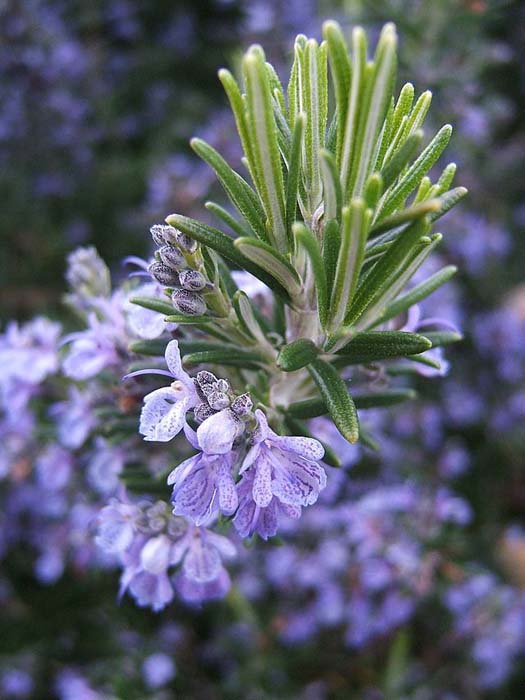Plants that offer good deer tolerance!
Published 11:01 am Sunday, May 21, 2023

- A SEASIDE SCENT: Rosemary can reach a height of 5-feet and a width of 3-feet. They leave a scent of the Mediterranean and are known for attracting birds and butterflies.
“In early June, the world of leaf and blade and flowers explodes, and every sunset is different.” – John Steinbeck.
“June is the gateway to summer.” – Jean Hersey.
Trending
“I wonder what it would be like to live in a world where it was always June.” – L. M. Montgomery.
“Spring being a tough act to follow, God created June.” – Al Bernstein.
“Far up in the deep blue sky, Great white clouds are floating by; All the world is dressed in green; Many happy birds are seen, Roses bright and sunshine clear Show that lovely June is here.” – F. G. Sanders.
“Be shore of yourself. Come out of your shell. Take time to coast. Avoid pier pressure. Sea life’s beauty. Don’t get so tied down on work that you miss out on life’s beautiful waves.” – Advice from the Ocean.
It only takes a few minutes of observation in our landscapes (from the mountains to the beaches, from the city to the country) to document that members of the wildlife family like to hang out in our spaces, too. Let’s make another observation — these spaces used to be their spaces, and we invaded their neighborhoods and “developed” them, thus sharing our landscapes with wildlife is a must do.
There are the birds (songbirds and birds of prey), the squirrels, the rabbits, the foxes, the turkeys, among others that we enjoy observing while they are frolicking about the grounds in search of food and shelter. And, the deer are pretty to observe too. However, these same deer may practice a pruning pattern to most plants while we sleep which will annoy us and possibly destroy every effort we make to improve the landscape. Pruning by deer is a problem in many of our landscapes leaving our plants battered and beaten up. However, we are actually the guilty party for continuing to invade their spaces through construction and development, thus minimizing natural areas where they have been free to roam and survive.
Trending
Damage to ornamental plants caused by deer has increased significantly during the last few years. and this damage is both an urban and a rural problem due to increasing deer populations and suburban development strategies into natural woodlands. Deer are selective feeders that usually move slowly through the landscape and eat leaves and twigs from different trees, shrubs, and plants by jerking and tearing leaves, stems, and twigs. Signs of deer damage include jagged edges on parts left intact, and annual and perennial plants which are partially or completely pulled out of the ground. Deer damage to larger trees is to the lower limbs (up to about 5 or 6 feet off the ground which is about the limitation of their reach).
Deer may feed on certain plants is some landscapes and not others. Such feeding patterns may be due to the availability of natural food sources between landscapes and the taste preferences of the individual deer. However, deer will eat almost any plant rather than face starvation. Deer favorites include narrow-leaf evergreens, daylilies, English ivy, hosta, and about any plant that has been fertilized.
Deer typically avoid prickly, poisonous or strong-scented plants. While many plants are deer tolerant, very few are deer-proof. Thus, careful plant selection should be a high priority where heavy deer populations thrive. Plants that offer good deer tolerance and distract deer with their aromatic (scented) foliage are listed as follows.
Asclepias tuberosa (butterfly weed): Reaching a height of 2 to 4 feet and a spread of 2 to 3 feet, this tough perennial offers clusters of orange flowers in the summer. It prefers placements in full sun (beds and borders) in a well-drained soil and tolerates heat and drought. It attracts many kinds of butterflies and works well in dried arrangements. Monarch butterfly larvae feed on its leaves but seldom harm this native plant. It is slow to emerge in the spring and deadhead faded blooms after flowering before seed development to limit spread. Works well with catmint, coreopsis and fountaingrass.
Dianthus spp. (dianthus or pinks): Reaching a height of 30-inches and a width of 18-inches, this enchanting, drought-tolerant perennial offers spicily fragrant flowers of pink, red, white, rose, and lavender in the spring, summer and fall and grass-like blue-green foliage. It prefers placement in full sun (containers, beds, borders and slopes) in a well-drained soil. It attracts hummingbirds and butterflies, and looks great as a cut flower and in dried arrangements. Works well with perennial geranium, coralbells, and iris.
Rosmarinus officinalis (rosemary): Reaching a height of 5-feet and a width of 3-feet, this drought-tolerant, evergreen, herbal shrub offers flowers with shades of pink or blue and leathery leaves with a scent of the Mediterranean. Leaves also add fresh herbal flavor in the kitchen preparations. It prefers placement in full sun (containers, beds, borders and slopes) in a well-drained soil with a gravel mulch. It is known as a symbol of remembrance and friendship, and fills the landscape with aroma, flavor, and activity (pollinating bees are attracted to the blooms). It attracts birds and butterflies.
Also, Acanthus mollis (Bear’s Breeches), Buxus sempervirens (English boxwood), Caryopteris spp. (bluebeard), Chrysanthemum spp. (mums), Crocosmia spp. (Crocosmia), Epimedium spp. (barrenwort or bishop’s cap), Eupatorium purpureum (Joe Pye Weed), Juniperus spp. (Juniper), Kniphofia spp. (red-hot poker), Perovskia atriplicifolia (Russian sage), Phormium spp. (New Zealand flax), and Solidago spp. (goldenrod). and mint, thyme, French tarragon, lavender, chives, and sage.
Deer are often frightened away by loud noises and sudden movement. Also, hang wind chimes from the branches of trees and shrubs, place wind spinners throughout your garden, or install a motion-activated sprinkler that will startle them with a sudden spray of water. Deer love the tender new leaves and shoots of groundcovers in the spring. As a distraction, treat area with deer repellent, blood meal, or fish emulsion. On another note, if crows are a problem, wave a white towel at them while you are audibly inviting them to exit the premises.
Enjoy these last few days of May as nature prepares us for the trifecta months of summer. And, please continue to pray for our mission team as we prepare to go to Peru early next month.
“For the Son of Man came to seek and to save what was lost.” Luke 19:10. “If anyone has material possessions and sees his brother in need but has no pity on him, how can the love of God be in him?” 1 John 3:17. “Do not withhold good from those who deserve it, when it is in your power to act.” Proverbs 3:27. “The LORD has made the heavens His throne; from there He rules over everything.” Psalm 103:19. “Let me hear in the morning of Your steadfast love, for in You I trust. Make me know the way I should go, for to You I lift up my soul.” Psalm 143:8.





